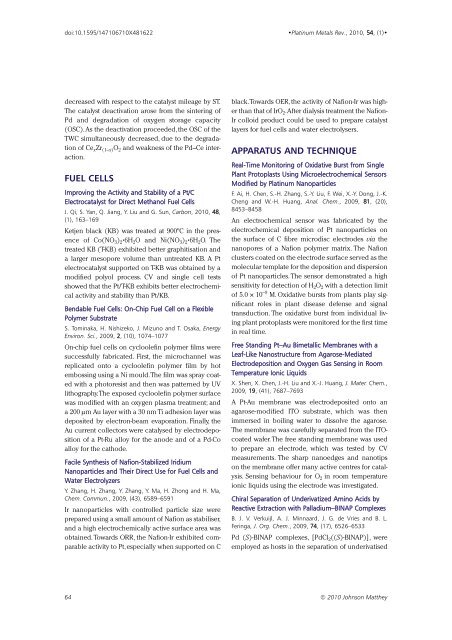Download Issue PDF - Platinum Metals Review
Download Issue PDF - Platinum Metals Review
Download Issue PDF - Platinum Metals Review
You also want an ePaper? Increase the reach of your titles
YUMPU automatically turns print PDFs into web optimized ePapers that Google loves.
doi:10.1595/147106710X481622<br />
•<strong>Platinum</strong> <strong>Metals</strong> Rev., 2010, 54, (1)•<br />
decreased with respect to the catalyst mileage by ST.<br />
The catalyst deactivation arose from the sintering of<br />
Pd and degradation of oxygen storage capacity<br />
(OSC).As the deactivation proceeded, the OSC of the<br />
TWC simultaneously decreased, due to the degradation<br />
of Ce x Zr (1–x) O 2 and weakness of the Pd–Ce interaction.<br />
FUEL CELLS<br />
Improving the Activity and Stability of a Pt/C<br />
Electrocatalyst for Direct Methanol Fuel Cells<br />
J. Qi, S. Yan, Q. Jiang, Y. Liu and G. Sun, Carbon, 2010, 48,<br />
(1), 163–169<br />
Ketjen black (KB) was treated at 900ºC in the presence<br />
of Co(NO 3 ) 2·6H 2 O and Ni(NO 3 ) 2·6H 2 O. The<br />
treated KB (T-KB) exhibited better graphitisation and<br />
a larger mesopore volume than untreated KB. A Pt<br />
electrocatalyst supported on T-KB was obtained by a<br />
modified polyol process. CV and single cell tests<br />
showed that the Pt/T-KB exhibits better electrochemical<br />
activity and stability than Pt/KB.<br />
Bendable Fuel Cells: On-Chip Fuel Cell on a Flexible<br />
Polymer Substrate<br />
S. Tominaka, H. Nishizeko, J. Mizuno and T. Osaka, Energy<br />
Environ. Sci., 2009, 2, (10), 1074–1077<br />
On-chip fuel cells on cycloolefin polymer films were<br />
successfully fabricated. First, the microchannel was<br />
replicated onto a cycloolefin polymer film by hot<br />
embossing using a Ni mould.The film was spray coated<br />
with a photoresist and then was patterned by UV<br />
lithography.The exposed cycloolefin polymer surface<br />
was modified with an oxygen plasma treatment; and<br />
a 200 μm Au layer with a 30 nm Ti adhesion layer was<br />
deposited by electron-beam evaporation. Finally, the<br />
Au current collectors were catalysed by electrodeposition<br />
of a Pt-Ru alloy for the anode and of a Pd-Co<br />
alloy for the cathode.<br />
Facile Synthesis of Nafion-Stabilized Iridium<br />
Nanoparticles and Their Direct Use for Fuel Cells and<br />
Water Electrolyzers<br />
Y. Zhang, H. Zhang, Y. Zhang, Y. Ma, H. Zhong and H. Ma,<br />
Chem. Commun., 2009, (43), 6589–6591<br />
Ir nanoparticles with controlled particle size were<br />
prepared using a small amount of Nafion as stabiliser,<br />
and a high electrochemically active surface area was<br />
obtained. Towards ORR, the Nafion-Ir exhibited comparable<br />
activity to Pt,especially when supported on C<br />
black.Towards OER, the activity of Nafion-Ir was higher<br />
than that of IrO 2 .After dialysis treatment the Nafion-<br />
Ir colloid product could be used to prepare catalyst<br />
layers for fuel cells and water electrolysers.<br />
APPARATUS AND TECHNIQUE<br />
Real-Time Monitoring of Oxidative Burst from Single<br />
Plant Protoplasts Using Microelectrochemical Sensors<br />
Modified by <strong>Platinum</strong> Nanoparticles<br />
F. Ai, H. Chen, S.-H. Zhang, S.-Y. Liu, F. Wei, X.-Y. Dong, J.-K.<br />
Cheng and W.-H. Huang, Anal. Chem., 2009, 81, (20),<br />
8453–8458<br />
An electrochemical sensor was fabricated by the<br />
electrochemical deposition of Pt nanoparticles on<br />
the surface of C fibre microdisc electrodes via the<br />
nanopores of a Nafion polymer matrix. The Nafion<br />
clusters coated on the electrode surface served as the<br />
molecular template for the deposition and dispersion<br />
of Pt nanoparticles. The sensor demonstrated a high<br />
sensitivity for detection of H 2 O 2 with a detection limit<br />
of 5.0 × 10 –9 M. Oxidative bursts from plants play significant<br />
roles in plant disease defense and signal<br />
transduction. The oxidative burst from individual living<br />
plant protoplasts were monitored for the first time<br />
in real time.<br />
Free Standing Pt–Au Bimetallic Membranes with a<br />
Leaf-Like Nanostructure from Agarose-Mediated<br />
Electrodeposition and Oxygen Gas Sensing in Room<br />
Temperature Ionic Liquids<br />
X. Shen, X. Chen, J.-H. Liu and X.-J. Huang, J. Mater. Chem.,<br />
2009, 19, (41), 7687–7693<br />
A Pt-Au membrane was electrodeposited onto an<br />
agarose-modified ITO substrate, which was then<br />
immersed in boiling water to dissolve the agarose.<br />
The membrane was carefully separated from the ITOcoated<br />
wafer.The free standing membrane was used<br />
to prepare an electrode, which was tested by CV<br />
measurements. The sharp nanoedges and nanotips<br />
on the membrane offer many active centres for catalysis.<br />
Sensing behaviour for O 2 in room temperature<br />
ionic liquids using the electrode was investigated.<br />
Chiral Separation of Underivatized Amino Acids by<br />
Reactive Extraction with Palladium–BINAP Complexes<br />
B. J. V. Verkuijl, A. J. Minnaard, J. G. de Vries and B. L.<br />
Feringa, J. Org. Chem., 2009, 74, (17), 6526–6533<br />
Pd (S)-BINAP complexes, [PdCl 2 ((S)-BINAP)], were<br />
employed as hosts in the separation of underivatised<br />
64 © 2010 Johnson Matthey
















